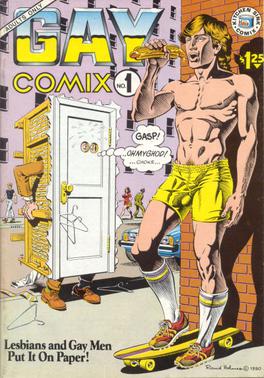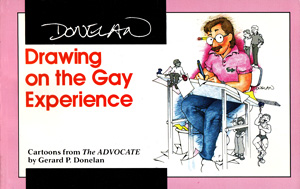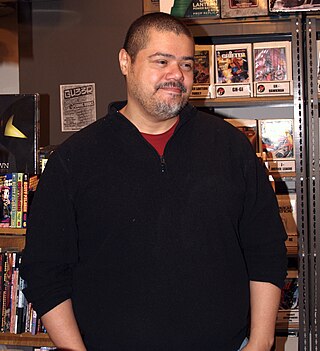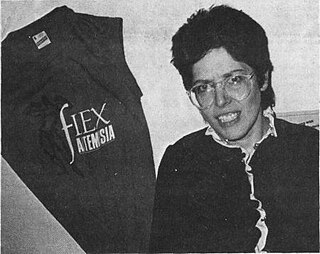
Howard Cruse was an American alternative cartoonist known for the exploration of gay themes in his comics. First coming to attention in the 1970s, during the underground comix movement with Barefootz, he was the founding editor of Gay Comix in 1980, created the gay-themed strip Wendel during the 1980s, and reached a more mainstream audience in 1995 when an imprint of DC Comics published his graphic novel Stuck Rubber Baby.

Jerry A. Mills was an openly gay cartoonist known for his comic strip Poppers, which is credited as one of the first comic strips to develop multi-dimensional gay characters. Scholars have stated that while earlier comics had relied on stereotypes such as the nelly queen or muscleman, Mills presented his characters with lives beyond the stereotypes. His work is also credited as having helped shape comics for the LGBTQ+ community and its members.
Roberta Gregory is an American comic book writer and artist best known for the character Bitchy Bitch from her Fantagraphics Books series Naughty Bits. She is a prolific contributor to many feminist and underground anthologies, such as Wimmen's Comix and Gay Comix.

Trina Robbins was an American cartoonist. She was an early participant in the underground comix movement, and one of the first women in the movement. She co-produced the 1970 underground comic It Ain't Me, Babe, which was the first comic book entirely created by women. She co-founded the Wimmen's Comix collective, wrote for Wonder Woman, and produced adaptations of Dope and The Silver Metal Lover. She was inducted into the Will Eisner Hall of Fame in 2013 and received Eisner Awards in 2017 and 2021.
Robert Kirby is an American cartoonist, known for his long-running syndicated comic Curbside – which ran in the gay and alternative presses from 1991 to 2008 – and other works focusing on queer characters and community, including Strange Looking Exile, Boy Trouble, THREE, and QU33R.
Mary Wings was an American cartoonist, writer, and artist. She was known for highlighting lesbian themes in her work. In 1973, she made history by releasing Come Out Comix, the first lesbian comic book. She also wrote a series of detective novels featuring lesbian heroine Emma Victor. Divine Victim, Wings' only Gothic novel, won the Lambda Literary Award for Lesbian Mystery in 1994.

Gay Comix is an underground comics series published from 1980 to 1998 featuring cartoons by and for gay men and lesbians. The comic books had the tagline "Lesbians and Gay Men Put It On Paper!"
Robert Triptow is an American writer and artist. He is known primarily for creating gay- and bisexual-themed comics and for editing Gay Comix in the 1980s, and he was identified by underground comix pioneer Lee Marrs as "the last of the underground cartoonists."
G. B. Jones is a Canadian artist, filmmaker, musician, and publisher of zines. She is best known for producing the queer punk zine J.D.s and her Tom Girls drawings.

Gerard P. Donelan, known mononymously as Donelan, is an openly gay cartoonist. Part of the first wave of LGBT cartoonists, he drew "It's a Gay Life", a regular single-panel cartoon feature in The Advocate, for 15 years.

Ivan Velez Jr. is an openly gay Latino American cartoonist, writer, museum educator, and teaching artist, known for creating the groundbreaking comic book series Tales of the Closet, and for his work with the DC Comics imprint Milestone Media, and with Marvel Comics.
Carl Vaughn Frick – often credited as Vaughn Frick or simply Vaughn – is an alternative cartoonist known for the exploration of gay, environmental, HIV/AIDS awareness, and radical political themes in his comics. His Watch Out! Comix #1 (1986) was an influential gay-themed comic, one of the first by an openly gay male cartoonist. His work was also included in issues of Gay Comix,Meatmen, Strip AIDS, No Straight Lines, and So Fey, a collection of Radical Faerie fiction.
Rupert Kinnard also credited as Prof. I.B. Gittendowne, is an American cartoonist who created the first ongoing gay/lesbian-identified African-American comic-strip characters: the Brown Bomber and Diva Touché Flambé. Kinnard is gay and African American.
Joan Hilty is an American cartoonist, educator, and comic book editor. She was a Senior Editor for mainstream publisher DC Comics and currently works for Nickelodeon as Editorial Director for graphic novels, comics, and legacy properties. Hilty works independently as both a writer-artist and editor.
Strip AIDS and Strip AIDS U.S.A. are comics anthology volumes published in 1987 in the UK, and 1988 in the US (respectively). They combined short comics with educational and sometimes comedic themes, to educate readers about HIV disease and safer sex, and to raise funds for the care of people with AIDS.

No Straight Lines is an anthology of queer comics covering a 40-year period from the late 1960s to the late 2000s. It was edited by Justin Hall and published by Fantagraphics Books on August 1, 2012.
Burton Clarke is a gay African-American alternative cartoonist. He is known for his contributions to the rise of LGBT comics and his focus on representing gay men of all races and classes in his art, using a mix of realism and fantasy to tackle complex issues such as internalized racism and homophobia.
Angela Bocage is a bisexual comics creator who published mainly in the 1980s and 1990s. Bocage was active in the queer comics community during these decades, publishing in collections like Gay Comix,Strip AIDS USA, and Wimmen's Comix. Bocage also created, edited, and contributed comics to Real Girl, a comics anthology published by Fantagraphics.
David Kelly is an American cartoonist and comics creator. He is best known for his strip, Steven’s Comics, which ran in LGBT and alternative newspapers and zines from 1994 to 1998. His strip has won the Xeric award and he has worked alongside critically acclaimed cartoonist Robert Kirby. He and Kirby co-edited the gay comics zine series Boy Trouble.

Nicole Ferentz is an American cartoonist, illustrator, graphic designer, and teacher. Her works cover feminist themes, lesbian themes, and themes of illness. Her comics have been featured in prominent queer comics like Gay Comics.









